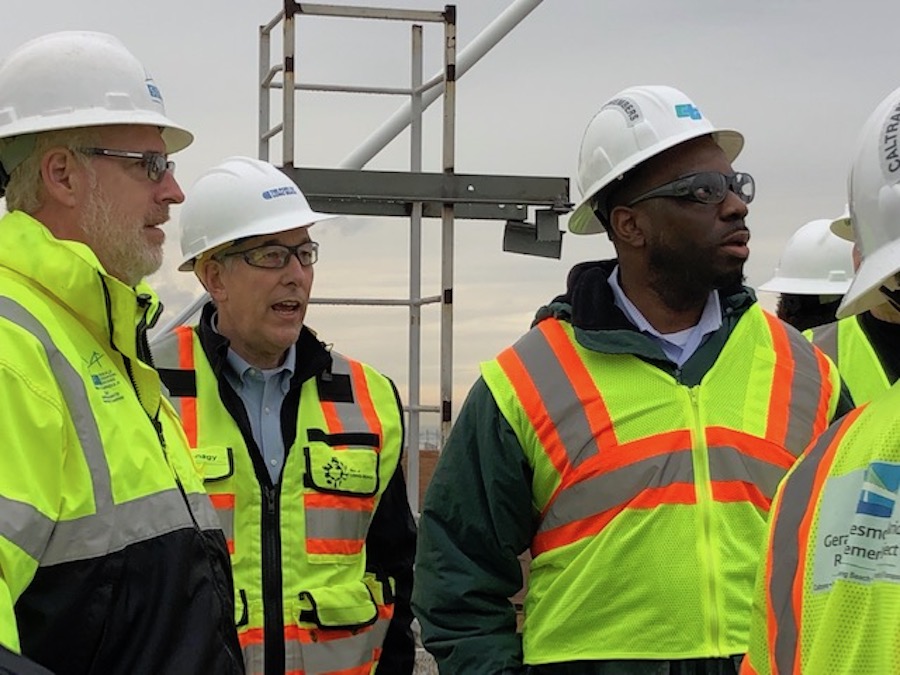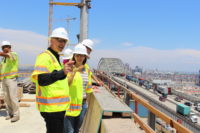Transportation
Ten Minutes With Caltrans Director Toks Omishakin

Toks Omishakin (right) gets a project briefing from Bob Schraeder (left), project manager for general contrator SFI and Duane Kenagy, capital programs executive for the Port of Long Beach, at the Gerald Desmond Bridge project. Photo: Aileen Cho for ENR
On Dec. 6, new California Dept. of Transportation (Caltrans) director Toks Omishakin visited the Port of Long Beach and the construction site of the new Gerald Desmond Bridge in Long Beach. He came to Caltrans following eight years with the Tennessee Dept. of Transportation (TDOT), where he established environmental, multimodal and planning policies as deputy commissioner with a $300-million annual budget. ENR Senior Transportation Editor Aileen Cho interviewed him between site visits.The interview has been condensed and edited.
How long have you been on the job and what projects have impressed you so far on your Caltrans district tours?
Six weeks. Now I'm an expert at all things Caltrans (laughing). Today is one of the ones I’m looking forward to. The Gerald Desmond Bridge is significant not only for California but nationally. It will impact 10% of the waterborne freight going through the country. I also got to see the [San Francisco-Oakland] Bay Bridge and the Golden Gate Bridge from the water.
Do you plan to promote alternative project delivery methods like design-build and P3s?
I believe in alternative project delivery. These methods should be very much on the table for the appropriate projects. I don’t think we can use them on every single one. Certain projects make more sense. But things like CMGC and ABC methods, should be things we look at, not only because of the financial benefits and savings, but for environmental impacts as well.
What changes do you plan to make at Caltrans?
Changes that need to be made at DOTs start with three places: Policy standpoint – that means department policy, executive orders and such to say, here’s where we're headed. Design guidelines and manuals need to be updated as part of that policy. Training for staff—we have a lot of tenured staff who need to learn new tools and methods that communities are looking for. Funding—we have to figure out how to align funding to match policy and training.
I was able to that in my prior role. We got a policy done. I and TDOT's chief engineer drafted the policy. We updated all design manuals by outsourcing to a consulting firm. Smart Growth America and SSTI [State Smart Transportation Initiative, a team of Smart Growth American and the University of Wisconsin] worked with our engineers to get up to speed on newer standards that are more multimodal-friendly. We got $30 million into active transportation modes—walking facilities, biking paths, transit connections, bus shelters.
How will implementing these programs be different in California?
It really depends on the context. In Tennessee, what mattered to internal stakeholders was economic development and safety. That’s how those cases were made. I couldn’t talk about climate change for investment. Here, the context is still safety. Almost 10 people die every day as part of the modal network. That's a big case to be made. Vulnerable users must be made safer. The environmental argument is pretty strong as well. The majority [of Californians] get it. They understand impact of climate change. As an agency we can go even into more rural parts of California and have a merit-based conversation about how improving walkability can impact the economy.
Advocates for active transportation modes have expressed frustration with Caltrans. For example, Senator Scott Wiener tried to push SB 127 that would require Caltrans to incorporate “Complete Streets” design in its highways, but met resistance. How do you plan to address this?
I understand their frustrations and doubt. But there are a lot of willing Caltrans staff who already get this. My job is to motivate and encourage them. There are people who know way more about what we need to focus on. We will have a serious dialogue with people working on SB 127.
What are your top priorities?
First, safety. Engineering, education, and enforcement to drive those [fatalities and injuries] numbers down. It's not just a talking point. Come to me in six months and ask me, what have you done?
The second is multimodalism. Caltrans needs to be looking at people movement across the board, from managed lanes down to pedestrians, cyclists, transit. As for freight, goods movement shouldn’t just happen on rubber wheels.
Third, efficiencies. We’re a very large 20,000-member, $15-billion budget agency. We can’t be lax in managing the funding we receive. How do we maximize or optimize the most internally and in delivering projects?
Then innovation and creativity. How do we come up with new concepts and ideas even though we're a 100+-year-old agency, 45 years as Caltrans? We don’t need to be still doing business as usual in many areas.
Finally, community and stakeholder engagement. We will take a step back to have broad conversations with communities, businesses, and neighborhoods where we go to them and say "here’s what we’re thinking about doing." We don't just wait for them to come to us. That’s how we build a better relationship. These projects are not for Caltrans, they're for Californians.
How many more districts have you visited and how many more to go?
I've visited five districts already, almost at the halfway mark. I've hit the ground running hard and Caltrans staff have really taken care of me.



